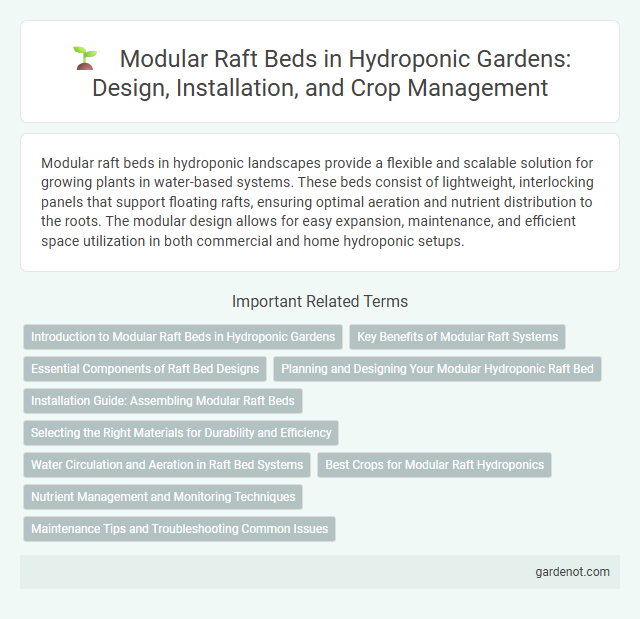Modular raft beds in hydroponic landscapes provide a flexible and scalable solution for growing plants in water-based systems. These beds consist of lightweight, interlocking panels that support floating rafts, ensuring optimal aeration and nutrient distribution to the roots. The modular design allows for easy expansion, maintenance, and efficient space utilization in both commercial and home hydroponic setups.
Introduction to Modular Raft Beds in Hydroponic Gardens
Modular raft beds in hydroponic gardens offer a scalable and efficient method for growing plants on nutrient-rich water without soil. Each module consists of a floating platform that supports plants while allowing roots to access oxygen and nutrients directly from the water below. This system enhances crop yield and simplifies maintenance by enabling easy expansion and replacement of individual raft sections.
Key Benefits of Modular Raft Systems
Modular raft systems in hydroponic landscapes offer enhanced scalability and flexibility, allowing for easy expansion or reconfiguration based on plant growth needs. These systems improve water efficiency by enabling precise nutrient delivery and recirculation, reducing waste and promoting sustainable practices. Additionally, modular rafts facilitate uniform plant growth and simplify maintenance, increasing overall productivity and operational efficiency.
Essential Components of Raft Bed Designs
Modular raft bed designs in hydroponic landscapes incorporate essential components such as buoyant rafts made from lightweight, durable materials like expanded polystyrene, providing stable plant support. Integrated nutrient film channels ensure optimal water and nutrient circulation beneath the rafts, promoting efficient oxygenation and root access. Precise water level regulation and aeration systems are critical to maintaining ideal growing conditions and maximizing plant health within the modular framework.
Planning and Designing Your Modular Hydroponic Raft Bed
Effective planning and designing of a modular hydroponic raft bed involves selecting durable, food-safe materials like high-density polyethylene for the base to ensure longevity and water resistance. Optimizing spacing between rafts enhances nutrient distribution and plant growth by maximizing light exposure and preventing overcrowding. Integrating efficient water flow systems and access points simplifies maintenance and supports consistent oxygenation for healthy root development.
Installation Guide: Assembling Modular Raft Beds
Assembling modular raft beds involves securely connecting interlocking panels to create a stable floating platform ideal for hydroponic crops. Ensuring airtight seals between sections prevents water leakage and maintains optimal buoyancy for consistent nutrient delivery. Proper alignment and level placement of each raft module enhance system efficiency and promote uniform plant growth.
Selecting the Right Materials for Durability and Efficiency
Selecting the right materials for modular raft beds in hydroponic landscapes ensures long-lasting durability and efficient water retention. High-density polyethylene (HDPE) provides excellent resistance to UV rays and chemical corrosion while maintaining lightweight properties for easy handling. Using corrosion-resistant metals or recycled plastic composites enhances structural integrity and supports sustainable hydroponic system performance.
Water Circulation and Aeration in Raft Bed Systems
Modular raft bed systems optimize water circulation through interconnected channels that ensure uniform nutrient distribution and oxygen availability for plant roots. Advanced aeration techniques, such as integrated air pumps and diffusers, enhance dissolved oxygen levels critical for root respiration and plant health. Efficient water flow and aeration combined reduce stagnation, promoting robust growth and minimizing disease risks in hydroponic landscapes.
Best Crops for Modular Raft Hydroponics
Lettuce, spinach, and kale thrive in modular raft hydroponic systems due to their shallow root structures and fast growth rates. Herbs such as basil, cilantro, and mint also perform well, benefiting from consistent nutrient delivery and oxygenation in raft beds. Strawberries and certain flowering plants can be successfully cultivated in modular raft setups when water parameters are carefully controlled.
Nutrient Management and Monitoring Techniques
Modular raft beds in hydroponic landscapes enable precise nutrient management by facilitating uniform nutrient distribution and optimal oxygenation for plant roots. Advanced monitoring techniques, such as real-time sensors for pH, electrical conductivity (EC), and dissolved oxygen levels, ensure consistent nutrient availability and prevent deficiencies or toxicities. Integrating automated nutrient dosing systems with these sensors enhances efficiency, promoting healthier plant growth and maximizing yield.
Maintenance Tips and Troubleshooting Common Issues
Modular raft beds in hydroponic landscapes require regular inspection of water levels, nutrient concentration, and pH balance to ensure optimal plant growth. Cleaning algae buildup and checking for blockages in the water circulation system prevents common issues such as root rot and oxygen deprivation. Routine monitoring and prompt adjustment of system parameters maintain a healthy, efficient hydroponic environment.
Modular raft bed Infographic

 gardenot.com
gardenot.com